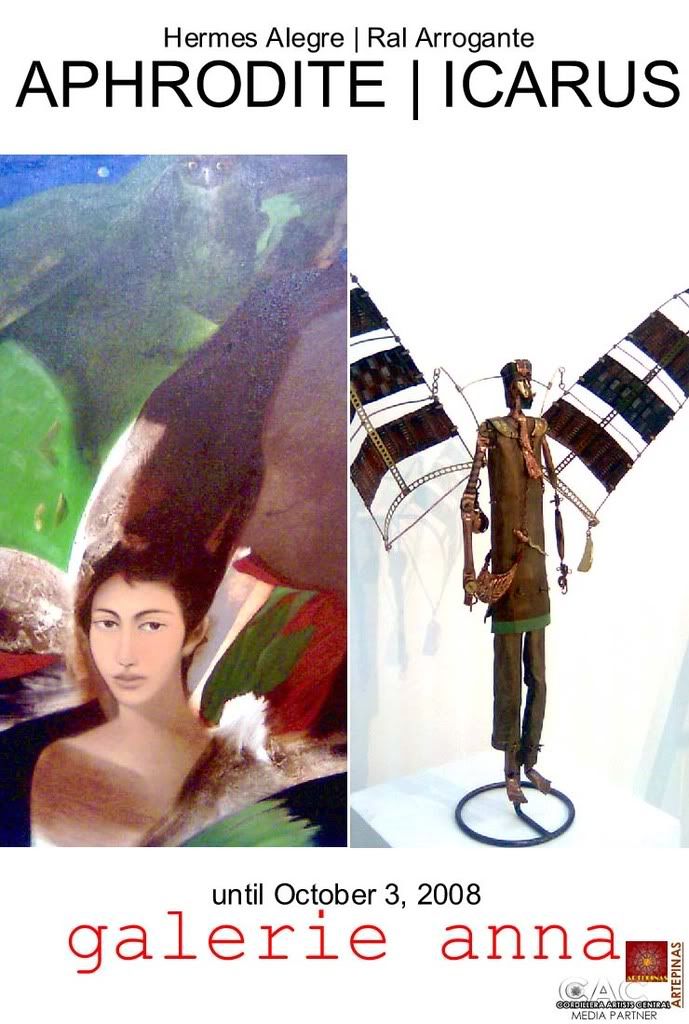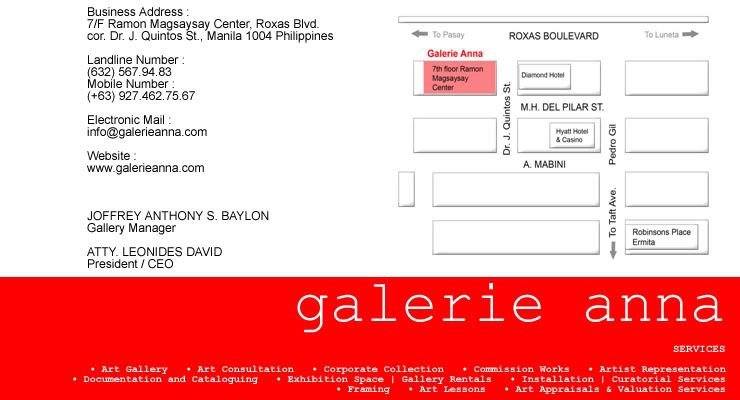

OF LOVERS AND DREAMERS
Hermes Alegre and Ral Arrogante in Aphrodite/Icarus
Reuben Ramas Cañete, Ph.D.
Mythology has a way of teaching us how to be the best of ourselves. Although mythology can, of course, construct a false picture of the world (witness the imaginings of bodily perfection and illusory equality found in popular culture, one that was critiqued as far ago as 1958 by French Poststructuralist Roland Barthes), it can nonetheless project one’s emotional and social vision of what can be ideally possible, given the real limitations of material existence. This was the rationale behind Plato’s Republic, where the act of banishing artists, and privileging philosophers in the ideal city-state was based on the vision of the Ideal: that the pursuit and perfection of knowledge and ideas would result in a more truthful and authentic lived experience than the falsities of illusionistic depiction.
In this Postmodern day and age, mythology has once more become a “real entity” due to the questioning of essentialism, reductionism, and the revealed fallacy of logocentrism. Postmodernism has also revealed the tenacity of a lived illusion that becomes more real than reality itself. In popular cultural terms, one can collapse this into the famous scene in the 1999 film The Matrix, when Morpheus reveals to Neo the basis of the Matrix’s existence as an illusory world constructed to benefit the machines, relying on the power of docile human bodies whose warmth it needs for power, but whose minds the Matrix has to satisfy by allowing them to dream their respective (but illusory) lives.
This realization is important, not because we want the world to remain hooked on fantasies at the expense of material realities, but because the human mind is capable of transforming the real world into a fantasy which it can justify as our own utopia. Art has this power to transform us by transfixing our mental gaze to an ideal world, a world that can be made real by economics, power, and the social networks that bind and liberate individuals to choose their respective paths of life.
Thus, Aphrodite/Icarus, the current two-man exhibition of paintings by Hermes Alegre, and sculptures by Ral Arrogante, should be qualified as an “awakening dream,” a realization of the power of myths not only to entrance and entrap, but also to liberate, renew, and re-imagine. Alegre’s paintings of idealized women, often located in the rural outdoors, and armored with their entrancing shawls, skimpy skirts, and robust bodies, not only shows the power of women that make men “weak at the knees,” they are also embodiments of the national mythology of female fertility as the fundamental icon to spur patriotic (hence, masculine) virility. Located in a deeper tradition of secular painting leading all the way to Fernando Amorsolo’s archetypical dalagang bukid, Alegre’s women nevertheless contains the energy, sensuality, and polysemy of the contemporary Filipina, whose more than equal contribution to the political economy through their vast quantities of often-unacknowledged labor, both domestic and overseas, allows the nation itself to survive, and sustain their families. Alegre shows these women in the eyes of a lover, whose passion to be with them speaks not necessarily of sexual inequality and hedonism, but rather of the need for men to also justify their lived production via an edificatory—and nowadays complementary—salute to the economy of gender.
Ral Arrogante’s sculptures, on the other hand, deal with the specifically masculine dream for flight. Arrogante’s unique approach to sculpture via the use of recycled brass and copper metal scrap, refashioned by hand into fantastic and phantasmagoric devices, beings, and creatures, belies the capacity of human beings for ecological annihilation. Rather, Arrogante dredges up the valuable refuse of contemporary humanity’s wasteful material technology to form memnonically valuable, post-apocalyptic relics of humanity’s capacity to remember and renew. Shaped into winged insects, ancient biplanes, gyrocopters, and human-powered gliders (complete with human-powered “engines”) Arrogante’s sculpture awakens us in two directions. Firstly, his work triggers our memories for an often-suppressed childhood, of our lost time in carefree play and innocent nothingness. Secondly, he allows us to realize our present and future, by contrasting our current world of wasteful production and our own maxed-out multitasked urbanity; as well as the more ominous tomorrow filled with the dire predictions of global-warmed cataclysms, social collapse into “pre-technology,” and the reduction of the human world into “the few but the fit.”
These works, when combined together, shows the power of contemporary Philippine Art to outgrow its listless co-practitioners, whose love for their own bluster and bluff fails to mask their ignorance and inconsequence. For a dream to be successful, it must allow us to realize the roots of our past, and the transformative power that great ideas bring to the human condition. Harking to the mythological attributes of two famed Greek figures, the goddess of love (Aphrodite), and the doomed son of humanity’s greatest inventor (Icarus), the works of Hermes Alegre and Ral Arrogante speak of the Filipino present through the memories of our past, but use this metalanguage to allow us to think of the way out of the emerging darkness of tomorrow. That art still has that power to transform means that mythology, for all its dysfunctionalities, still has a role to play in the realization of our dreams.
Hermes Alegre and Ral Arrogante in Aphrodite/Icarus
Reuben Ramas Cañete, Ph.D.
Mythology has a way of teaching us how to be the best of ourselves. Although mythology can, of course, construct a false picture of the world (witness the imaginings of bodily perfection and illusory equality found in popular culture, one that was critiqued as far ago as 1958 by French Poststructuralist Roland Barthes), it can nonetheless project one’s emotional and social vision of what can be ideally possible, given the real limitations of material existence. This was the rationale behind Plato’s Republic, where the act of banishing artists, and privileging philosophers in the ideal city-state was based on the vision of the Ideal: that the pursuit and perfection of knowledge and ideas would result in a more truthful and authentic lived experience than the falsities of illusionistic depiction.
In this Postmodern day and age, mythology has once more become a “real entity” due to the questioning of essentialism, reductionism, and the revealed fallacy of logocentrism. Postmodernism has also revealed the tenacity of a lived illusion that becomes more real than reality itself. In popular cultural terms, one can collapse this into the famous scene in the 1999 film The Matrix, when Morpheus reveals to Neo the basis of the Matrix’s existence as an illusory world constructed to benefit the machines, relying on the power of docile human bodies whose warmth it needs for power, but whose minds the Matrix has to satisfy by allowing them to dream their respective (but illusory) lives.
This realization is important, not because we want the world to remain hooked on fantasies at the expense of material realities, but because the human mind is capable of transforming the real world into a fantasy which it can justify as our own utopia. Art has this power to transform us by transfixing our mental gaze to an ideal world, a world that can be made real by economics, power, and the social networks that bind and liberate individuals to choose their respective paths of life.
Thus, Aphrodite/Icarus, the current two-man exhibition of paintings by Hermes Alegre, and sculptures by Ral Arrogante, should be qualified as an “awakening dream,” a realization of the power of myths not only to entrance and entrap, but also to liberate, renew, and re-imagine. Alegre’s paintings of idealized women, often located in the rural outdoors, and armored with their entrancing shawls, skimpy skirts, and robust bodies, not only shows the power of women that make men “weak at the knees,” they are also embodiments of the national mythology of female fertility as the fundamental icon to spur patriotic (hence, masculine) virility. Located in a deeper tradition of secular painting leading all the way to Fernando Amorsolo’s archetypical dalagang bukid, Alegre’s women nevertheless contains the energy, sensuality, and polysemy of the contemporary Filipina, whose more than equal contribution to the political economy through their vast quantities of often-unacknowledged labor, both domestic and overseas, allows the nation itself to survive, and sustain their families. Alegre shows these women in the eyes of a lover, whose passion to be with them speaks not necessarily of sexual inequality and hedonism, but rather of the need for men to also justify their lived production via an edificatory—and nowadays complementary—salute to the economy of gender.
Ral Arrogante’s sculptures, on the other hand, deal with the specifically masculine dream for flight. Arrogante’s unique approach to sculpture via the use of recycled brass and copper metal scrap, refashioned by hand into fantastic and phantasmagoric devices, beings, and creatures, belies the capacity of human beings for ecological annihilation. Rather, Arrogante dredges up the valuable refuse of contemporary humanity’s wasteful material technology to form memnonically valuable, post-apocalyptic relics of humanity’s capacity to remember and renew. Shaped into winged insects, ancient biplanes, gyrocopters, and human-powered gliders (complete with human-powered “engines”) Arrogante’s sculpture awakens us in two directions. Firstly, his work triggers our memories for an often-suppressed childhood, of our lost time in carefree play and innocent nothingness. Secondly, he allows us to realize our present and future, by contrasting our current world of wasteful production and our own maxed-out multitasked urbanity; as well as the more ominous tomorrow filled with the dire predictions of global-warmed cataclysms, social collapse into “pre-technology,” and the reduction of the human world into “the few but the fit.”
These works, when combined together, shows the power of contemporary Philippine Art to outgrow its listless co-practitioners, whose love for their own bluster and bluff fails to mask their ignorance and inconsequence. For a dream to be successful, it must allow us to realize the roots of our past, and the transformative power that great ideas bring to the human condition. Harking to the mythological attributes of two famed Greek figures, the goddess of love (Aphrodite), and the doomed son of humanity’s greatest inventor (Icarus), the works of Hermes Alegre and Ral Arrogante speak of the Filipino present through the memories of our past, but use this metalanguage to allow us to think of the way out of the emerging darkness of tomorrow. That art still has that power to transform means that mythology, for all its dysfunctionalities, still has a role to play in the realization of our dreams.



















































































































































































No comments:
Post a Comment